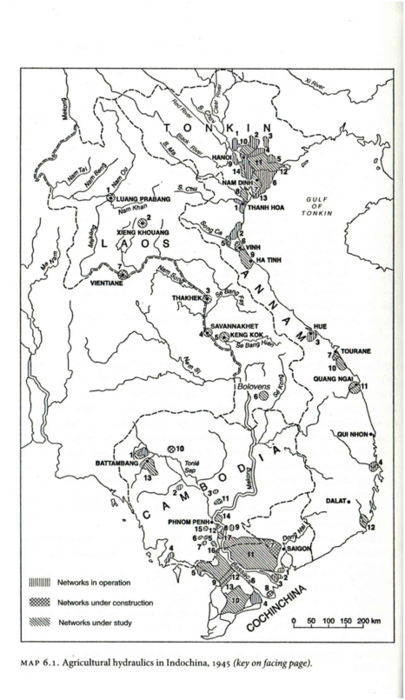
| ICE Case Studies
|
|
I.
Case Background |

Vietnam's famine of 1944-5 was entirely man-made. The end of World War II, a retreating Japanese force, and a weak French government response, contributed to the calamity. Nonetheless, 1-2 million people perished in a famine brought on by rice rationing taken to support Japanese troop requirements. Some researchers believe that it served as an impetus for the August Revolution that created a period of nominal independence in North parts of Vietnam.
The Vietnamese famine of 1945 was regarded as a war crime, but besides Japan, the Viet Minh pointed a finger at France for the calamity. Whatever the cause, it is clear that a major calamity occurred in Vietnam during this time. The roots of the famine are in the war, rather than in nature.
Vichy France, under German rule, followed the policies of the Japanese occupiers throughout most of World War II. Seeing Germany weakened in Europe the Japanese decided to act and took control from the French and imprisoned them. When the Vichy government fell with the D-Day invasion in 1944 Japan took full control of Vietnam. Rice requisitions then increased.
Toward the end of the war, Japanese forces began pulling back as Allied forces neared the Japanese homeland. The famine was continuing when the United States bombed Hiroshima and Nagasaki and Japan suddenly surrendered. Due to this opportunity, and the build-up of grievances over long-term colonization and short-term famine, Vietnamese forces took control of many parts of the country, especially in the north.
Agricultural Hydraulics (Irrigation Systems) in Vietnam
(Indications of Rice Production Areas)

Vietnam served as a home for many Japanese soldiers who passed through to invade other parts of Southeast Asia. Japan has created a pact with Thailand where the Thais fought alongside the Japanese in several campaigns. In January, 1942, Thailand even declared war on the United States. The cost to Vietnam however mounted over time. Vichy France acquiesced to Japan's commands and forced the population to support the army, particularly in terms of food.
"It is nevertheless clear that continued heavy rice requisitions demanded by the Japanese and implemented by the Vichy French in a situation of administrative breakdown and even semi-anarchy after the Japanese coup, magnified the impact of the disaster. Human failure and agency combined to betray the people of northern and north-central Vietnam." (Gunn)
The famines were especially pronounced in the major rice-growing regions in the north around the Red River, and in the south along the Mekong River.

"According to Pham Cao Duong, a standard interpretation is that the origins of the famine of 1945 lie with the crop failures of 1943-45; this was compounded by lack of dike maintenance following US bombing of the north and the catastrophic rainfall of August-September 1944 causing flooding and loss of rice plants." (Gunn)
However it is important to note the loss of foodstuffs due to compulsory sales to the Japanese military of rice and other basic commodities.
Most of the rice Japan requisitioned was from the north and the Red River Valley. At the same time, the north region was undergoing a huge population spurt. It was this imbalance that led to the famine. A contemporary cartoon captures the Vietnamese national sentiment.

Hua Junwu,’Bumper Harvest’ The sack is labeled ‘rice.’ From JFRB, 3 November 1944

The Vichy government ruled in Vietnam until March 1945 when the Japanese military took full control. Those French officials still in government were promptly arrested.
Two sources put total deaths in the millions. First, Gunn notes that "the deaths stemming from the great famine of 1944-45, which reached its zenith in March-April 1945 in Japanese-occupied northern Vietnam, eclipsed in scale all human tragedies of the modern period in that country up until that time. The demographics vary from French estimates of 600,000-700,000 dead, to official Vietnamese numbers of 1,000,000 to 2,000,000 victims." (Gunn. 2011).
This figure is echoed by Vietnamese officials. "Official Vietnamese estimates, first put forward in a famous speech by Hồ Chí Minh
and then reiterated with little empirical support until recently, place the number of people
who died within the space of six months at approximately two million (Nguyễn Khắc
Đạm 1988; Văn Tạo and Nguyễn Khắc Đạm 1988; Đảng Cộng sản Việt Nam 2008, 921;
Gunn 2014, 259n1)." (MacLean)

While a global battle, the famine was related to a regional strategy on the part of the Japanese in South-east Asia. Conflcit and bombings, especially from the U.S., destroyed infrastructure, especially irrigation systems. The systems were vital to Vietnam's rice production.
Japan was defeated and Vietnam suffered through a terrible famine with a huge loss of life. But was is determined? Perhaps not. Gunn says: "Affirming perhaps the more general thrust of Amartya Sen's arguments about the causes of famines, food distribution mechanisms broke down not in a situation of absolute scarcity as in some conflict situations but in an environment in which all signs pointed to the urgent need for surplus rice to be moved north from the Mekong delta." (Gunn)

Biafra Famine
South Sudan Civil War and Famine
30 Year's War and Famine
Cromwell's Famine
Vietnam Famine of 1945
Bengal Famine of 1943
North Korea Famine
Burkina Food Riots
Ukraine Famine
Go to Ice Search Engine and Scenario Builder
Bui Ming Dung, ”Japan's Role in the Vietnamese Starvation of 1944-45,” Modern Asian Studies, vol. 29, no.3, July, 1995, pp.575-76.
Geoffrey Gunn, "The Great Vietnamese Famine of 1944-45 Revisited", Asia Pacific Journal, January 24, 2011 Volume 9, Issue 5, Number 4, Source: http://apjjf.org/2011/9/5/Geoffrey-Gunn/3483/article.html
Ken MacLean, "History Reformatted:
Vietnam’s Great Famine (1944–45) in Archival Form"
Source" https://www.jstage.jst.go.jp/article/seas/5/2/5_187/_article
David Marr, Vietnam 1945: The Quest for Power, University of California Press, Berkeley, 1997.
Amartya Sen, Poverty and Famines: An Essay on Entitlement and Deprivation, Oxford University Press, Oxford, 1981.
Ken MacLean, "History Reformatted: Vietnam’s Great Famine (1944–45) in Archival Form", Southeast Asian Studies, Vol. 5, No. 2, August 2016, pp. 187–218, Source: https://www.jstage.jst.go.jp/article/seas/5/2/5_187/_pdf
